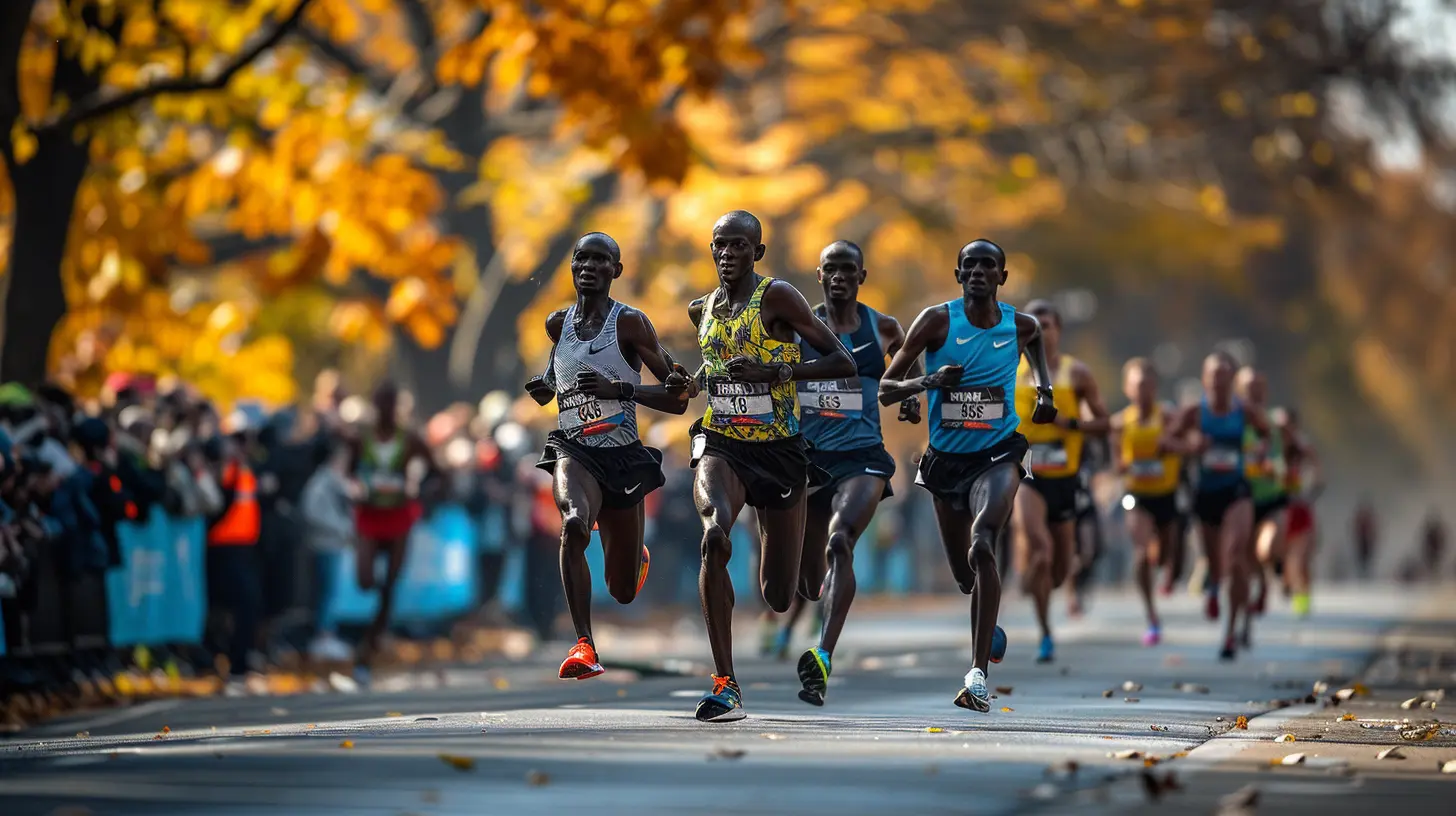How to Train for a Marathon Without a Coach
3 September 2025
So, you've decided to run a marathon—heck yeah! But here's the kicker: you're doing it without a coach. No problem. Not everyone has the time, money, or desire to hire someone to blow a whistle at them. The good news? You can absolutely train for a marathon solo and still cross that finish line with pride (and maybe a few tears of joy).
This guide is your no-nonsense, clear-as-day roadmap to getting marathon-ready without a coach breathing down your neck. You’re in control—let’s make it count.
Why Go Coach-Free?
First things first. Why train without a coach? Well, maybe:- You’re on a budget.
- You prefer flexibility over structure.
- You trust your intuition.
- You like learning and experimenting on your own.
Whatever your reason, trust it. Tons of runners have trained coach-free and crushed their goals. It’s totally doable—with the right prep.
Set Your Marathon Goals
Before you even lace up your sneakers, get real with your goals. Are you aiming to:- Simply finish?
- Beat a personal best?
- Qualify for another race (hello, Boston)?
Your goal will shape everything—your training plan, pace, mindset, even your running shoes. Be honest here. There's glory in every goal, whether it's crossing the finish line upright or shaving off 10 minutes.
Pick the Right Training Plan
Let’s not reinvent the wheel. Training plans are everywhere—and many are gold. Look for one that fits your schedule, your fitness level, and your goals.Some popular options include:
- Hal Higdon's Plans – Great for beginners to advanced runners.
- Nike Run Club – Comes with a sleek app, audio-guided runs, and progress tracking.
- Hansons Marathon Method – Ideal for folks chasing speed (but be ready to commit).
Choose a plan with a solid balance of long runs, easy runs, and rest days. Consistency is key—don’t skip long runs. Those are the backbone of your training.
Understand the Basics of Marathon Training
No coach? No problem. You just need to understand a few basic building blocks.1. The Long Run
This is your weekly endurance builder. Start with a distance you can handle and gradually increase by about 10% each week. Your longest run should be 18–22 miles and happen about 3 weeks before race day.Think of it like upping your credit limit—slow and steady so you don’t crash.
2. Easy Runs
These are low-effort runs that help build aerobic capacity without burning you out. Run at a pace where you could chat with a friend (or talk to yourself—it still counts).3. Tempo Runs
These are faster-paced runs meant to increase your lactate threshold. Basically, they help you get used to running faster without dying. Aim for a pace that feels “comfortably hard.”4. Speed Work
Not always necessary for beginners, but awesome for improving speed and efficiency. Intervals, strides, or fartleks (yes, that’s a real word) can spice things up.5. Rest and Recovery
Don't sleep on this (figuratively and literally). Rest days are when your body rebuilds and gets stronger. Honor them.Build a Weekly Schedule
Structure your training week around your lifestyle. A typical weekly schedule might look like this:- Monday: Rest or active recovery
- Tuesday: Tempo run
- Wednesday: Easy run or cross-training
- Thursday: Speed work or hill repeats
- Friday: Rest
- Saturday: Easy run
- Sunday: Long run
Shift things around based on your job, kids, or Netflix binges—the key is consistency, not perfection.
Don’t Skip Strength Training
Running is awesome, but it’s not enough. Add 2–3 days of strength training to keep your muscles balanced and injury-free.Focus on:
- Core (planks, crunches, Russian twists)
- Glutes (squats, lunges, hip thrusts)
- Legs (calf raises, step-ups)
- Upper body (push-ups, rows)
You don’t need a gym—bodyweight or resistance bands work wonders.
Stay Injury-Free
When you’re your own coach, it’s tempting to ignore little twinges or power through pain. Bad idea.Here’s your DIY injury prevention toolkit:
- Warm up and cool down: 5–10 minutes of brisk walking or dynamic stretches.
- Stretch and foam roll: Especially after long runs.
- Listen to your body: If something hurts (really hurts), take a rest day or see a pro.
- Don't skip rest days: These aren't optional—they're essential.
Your future self will thank you.
Fuel Like a Champion
You can’t run a marathon on fumes. Nutrition is your secret sauce.Daily Nutrition
- Eat whole, balanced meals.- Carbs are your BFFs—don’t fear them.
- Protein builds muscle—sneak some into every meal.
- Hydration is key—aim for half your body weight in ounces of water.
During Long Runs
- Start fueling before you’re starving.- Use gels, chews, or sports drinks every 45–60 minutes.
- Practice fueling during training—it’s like rehearsing for the big show.
Get Mentally Tough
Marathons are as much mental as physical. When your legs scream “nope,” your mind says “let’s go.”Here’s how to train your brain:
- Visualize success: Picture crossing the finish line strong.
- Use mantras: Short, powerful phrases like “strong and steady” or “I’ve got this.”
- Break the race into chunks: Focus on getting to the next mile marker, not mile 26.
- Expect the pain: Know it’s coming and know you can handle it.
Track Your Progress
Use an app, journal, or spreadsheet to log your runs, times, and how you felt. This helps you:- Spot training patterns
- Stay motivated
- Adjust your plan based on how your body responds
Apps like Strava, Garmin Connect, or Runkeeper do this beautifully—and give you cool bragging rights too.
Race Day Strategy: What to Remember
You’ve done the work. Now it’s showtime. Here’s the strategy:1. Stick to your pace: Don’t chase the speed demons—they’ll burn out.
2. Fuel early and often: Don’t wait until you’re dragging.
3. Soak in the vibes: High-five kids, thank volunteers, smile for the camera.
4. Trust your training: You’ve got the miles in your legs. Lean on that.
Common Pitfalls to Avoid
Even without a coach, you can steer clear of rookie mistakes:- Skipping rest days (nope!)
- Overtraining—more isn’t always better
- Ignoring pain or signs of injury
- Not practicing race-day nutrition
- Going out too fast on race day
Stay smart. Your body is talking—listen to it like it’s your favorite playlist.
Celebrate the Journey
Training for a marathon alone makes you part of a pretty elite club. The discipline, the early mornings, the blisters—it all adds up to something magical.After the race, don’t just focus on the time. Celebrate the journey. Write about it. Post about it. Frame your bib if that’s your thing.
You earned every step.
Final Thought
Can you train for a marathon without a coach? Absolutely. With the right plan, mindset, and a dash of grit, you're more than capable. You’re not just building mileage—you’re building belief. One run at a time.So go ahead—lace up, hit the road, and own it. The finish line’s waiting.
all images in this post were generated using AI tools
Category:
MarathonAuthor:

Uziel Franco
Discussion
rate this article
1 comments
Dixie McIntire
Self-discipline and consistency are key for success.
September 18, 2025 at 2:37 AM

Uziel Franco
Absolutely! Consistency in training and self-discipline are essential for reaching marathon goals. Stay committed, and you'll see progress!


![Breaking Records and Barriers: [Player Name]s Historic Season](/pictures/blog/small/breaking-records-and-barriers-player-names-historic-season_1.webp)